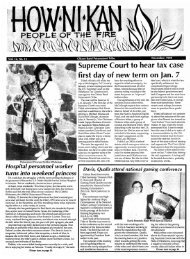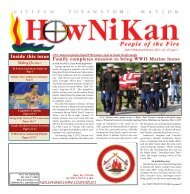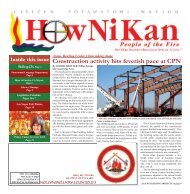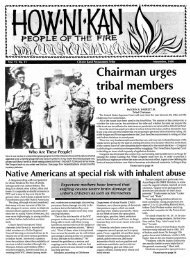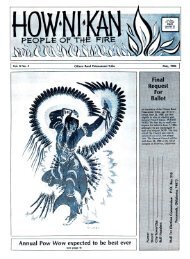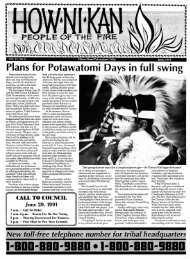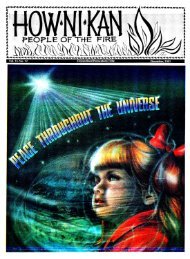October 2011 - Citizen Potawatomi Nation
October 2011 - Citizen Potawatomi Nation
October 2011 - Citizen Potawatomi Nation
Create successful ePaper yourself
Turn your PDF publications into a flip-book with our unique Google optimized e-Paper software.
16 HowNiKan <strong>October</strong> (Bnakwi Gises) <strong>2011</strong>, vol. 32 issue 5<br />
my students. Seems this current generation<br />
communicates differently than I have.<br />
What I discovered is an excellent way to<br />
keep track of friends and family. I want to<br />
invite all of you who have and use this new<br />
tool to feel free to “Friend” me on Facebook.<br />
Just don’t expect me to be one of<br />
those Facebook experts who seem to know<br />
Vice Chairman Linda Capps<br />
all the bells and whistles of it. All in good<br />
time…….<br />
As always it is both a pleasure and an<br />
honor to serve you and our great nation.<br />
Bama pi and migwetch,<br />
Paul Schmidlkofer<br />
Greetings,<br />
It may be of interest to those tribal members<br />
who live outside our <strong>Nation</strong>’s jurisdiction<br />
and the State of Oklahoma to compare<br />
employment status. First, the <strong>Citizen</strong><br />
<strong>Potawatomi</strong> <strong>Nation</strong> has 1,884 full and parttime<br />
employees. Our <strong>Nation</strong> is, by far, the<br />
largest employer in the area. We are proud<br />
of our numbers and proud of the fact that<br />
even with the ongoing economic crunch,<br />
we have maintained our employment level.<br />
Profits in some enterprises might be down<br />
slightly, but we have strived to conserve in<br />
order to keep our people employed.<br />
Both unemployment and underemployment<br />
continue to be a concern for all of<br />
Oklahoma, including our immediate area.<br />
Although Oklahoma’s unemployment rate<br />
of approximately 5.2% is among 11 other<br />
states in the low category range throughout<br />
the U.S.A. (3.6% - 6.9%), it appears that we<br />
can not declare a victory anytime soon.<br />
Oklahoma was one of 11 states that showed<br />
no change in employment rate from the previous<br />
month in August, which is disappointing.<br />
However, there was an<br />
improvement in the unemployment rate<br />
over the previous year - a 1.5% decrease.<br />
Oklahoma’s unemployment rate today is<br />
quite a contrast to December of 2000 when<br />
we reached a low level of unemployment of<br />
2.8%. It is also a contrast in the other direction<br />
when our unemployment rate rose to<br />
9.2% in June of 1983.<br />
All states provide some partial benefits<br />
for qualified unemployed workers. Underemployment<br />
has become such a concern for<br />
some parts of the country that there is actually<br />
an underemployment insurance offered<br />
by at least 20 states. This benefit is also referred<br />
to as the work-share benefit. The<br />
states offering underemployment insurance<br />
include Arizona, Arkansas, California, Colorado,<br />
Connecticut, Delaware, Florida,<br />
Iowa, Kansas, Louisiana, Maryland, Mississippi,<br />
Massachusetts, Michigan, New<br />
York, Oregon, Rhode Island, Texas, Vermont,<br />
and Washington.<br />
There are six other states presently considering<br />
work-share legislation, including<br />
Hawai’i, Ohio, Oklahoma, New Hampshire,<br />
New Jersey, and Pennsylvania.<br />
Underemployment occurs when your<br />
full-time work status has been cut by either<br />
your employer or you were laid off and had<br />
to accept a part-time position with a new<br />
employer. An individual applies for the underemployment<br />
benefits the same way he<br />
files for unemployment by contacting the<br />
Department of Labor in your state.<br />
The <strong>Citizen</strong> <strong>Potawatomi</strong> <strong>Nation</strong> will see<br />
a significant increase in employment during<br />
2012. Flintco has been chosen as the general<br />
contractor for the Grand Hotel project,<br />
which is in the beginning stages of construction.<br />
Flintco will be hiring numerous<br />
sub-contractors, skilled tradesmen, and laborers<br />
within the next few months. In addition,<br />
the <strong>Nation</strong>’s events arena, pizza<br />
restaurant, and sports complex will hire<br />
many full and part-time employees. Our<br />
<strong>Nation</strong> is blessed as we strive to progress in<br />
a slightly depressed economy.<br />
As always, I cherish the opportunity to<br />
server as your Vice Chairman.<br />
Migwetch,<br />
Linda Capps<br />
Chairman John Barrett<br />
Bozho, Nikan (Hello, my friend),<br />
Greetings from your tribal home. There<br />
is a great deal of activity here at Tribal<br />
Headquarters and at our other locations<br />
with 10 major projects underway. They may<br />
seem to be for random purposes but they all<br />
contribute toward a common goal. In this<br />
letter, I will try to summarize the Why, How,<br />
and What about activities and projects and<br />
describe how they fit into the short-,<br />
medium-, and long-term plans for the <strong>Citizen</strong><br />
<strong>Potawatomi</strong> <strong>Nation</strong>.<br />
The Tribal Legislature and Executive<br />
Branch recently held its annual strategic<br />
planning sessions along with training in<br />
tribal governance. It was conducted by the<br />
Native <strong>Nation</strong>s Institute (NNI) in Tucson,<br />
Arizona. NNI is a joint effort of the Udall<br />
Foundation at the University of Arizona and<br />
the Kennedy School of Government at Harvard<br />
University. The idea is to identify the<br />
steps we should take to keep the tribe<br />
headed in the right direction for our traditional<br />
“Seven Generations.”<br />
The old <strong>Potawatomi</strong> “Ogemas” (chiefs)<br />
made decisions and acted based on the immediate<br />
needs of the people, but the guiding<br />
consideration of their actions was: How<br />
will it affect the seven generations of<br />
<strong>Potawatomi</strong> who are coming to this world<br />
after you? The planning sessions were very<br />
fruitful and helped our entire elected leadership<br />
form a common future vision for the<br />
<strong>Nation</strong>: Improve the quality of life for our<br />
citizens and provide opportunities that encourage<br />
our people to benefit the tribal culture<br />
and benefit from it.<br />
For me, as Tribal Chairman for these<br />
many years, the absolute joy I feel in joining<br />
in the mixing of ideas and knowledge<br />
with all of our legislative and executive<br />
people is its own reward. From a historical<br />
perspective, it makes me even more aware<br />
of the loss we continue to experience from<br />
the scattering of our people by the federal<br />
government in the last 150 years.<br />
What if we had been able to keep our<br />
people and land together for those five generations?<br />
Can you just imagine how strong<br />
our future would be? With that in mind, isn't<br />
our biggest step on the road to that future to<br />
stop our “brain drain” - to give these next<br />
seven generations of smart and capable <strong>Citizen</strong><br />
<strong>Potawatomi</strong> a way to contribute their<br />
talent and energy to their tribe and family<br />
in a way that is mutually rewarding?<br />
I have a quote on my desk about my job:<br />
“Many persons have a wrong idea of what<br />
constitutes true happiness. It is not attained<br />
through self-gratification but through fidelity<br />
to a worthy purpose.”<br />
Working for our tribal <strong>Nation</strong>, directly or<br />
indirectly, does not have to mean you must<br />
totally sacrifice yourself or deny your ambitions.<br />
It means you can be happier in your<br />
life by sharing your abilities with your<br />
blood kin so that the next seven generations<br />
of your family have more opportunity. In<br />
the present day, the job of the <strong>Nation</strong>’s leadership<br />
is to grow that possibility, and at the<br />
same time provide daily services to our<br />
people who are in need. That is what all of<br />
this building and growth is about. That is<br />
the “Why” I mentioned in the first paragraph<br />
of this letter.<br />
Next is the “How we do it” part of our<br />
development plans. There is a new buzzword<br />
in business one hears all of the time:<br />
“Synergy.” The CPN believes the word is<br />
another way to describe the old adage:<br />
“Dance with the one what brung ya.” In<br />
other words, remember what got you where<br />
you are. Build on what you have. Innovation<br />
is seldom radical. It is usually a series<br />
of “half-steps” built on what is in place.<br />
That is what we think is smart and prudent.<br />
We are using the assets and talent the <strong>Nation</strong><br />
has in hand to grow - vertically or horizontally.<br />
Now I know that sounds like college<br />
business class mumbo-jumbo. What it<br />
means in real terms is: we got into the large<br />
discount grocery store business with our



